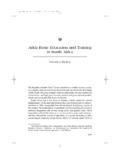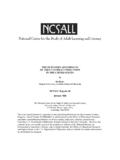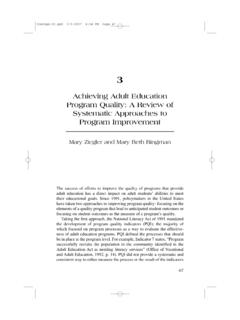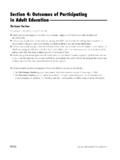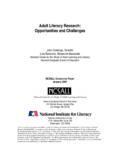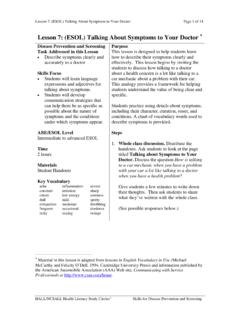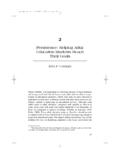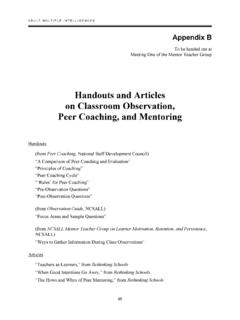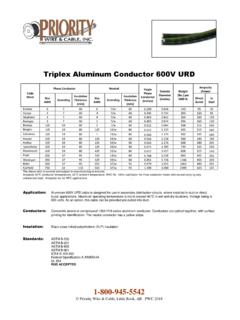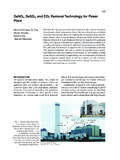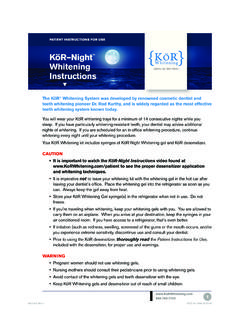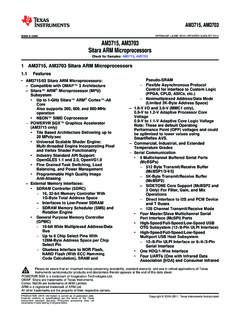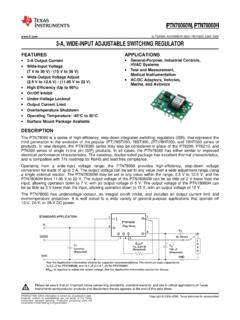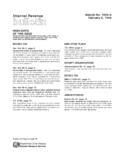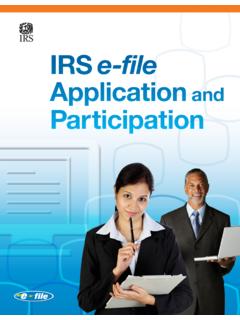Transcription of Research on Professional Development and Teacher Change ...
1 2/2/2007 7:20 PM Page 205. 7. Research on Professional Development and Teacher Change : Implications for Adult Basic Education Cristine Smith and Marilyn Gillespie There is no doubt that the current educational climate is driven by an over- riding concern with student achievement and what promotes it. This is true in K 12 education and, increasingly, in adult basic education (ABE). as well. The role of teachers in student achievement is central to this con- cern. According to the Department of Education, Research confirms that teachers are the single most important factor in raising student achievement. 39 Higher standards for teachers accompany the push for higher standards for students and greater accountability for student learn- ing, and Professional Development is a critical link among new policies, school reform, and improved educational practice (Knapp, 2003). In this chapter we draw on the K 12 and adult literacy education Research literature 39.
2 See 205. 2/2/2007 7:20 PM Page 206. 206 SMITH AND GILLESPIE. to examine two topics: (a) what is known about what makes Teacher pro- fessional Development effective, and (b) how teachers Change as a result of Professional Development . Before addressing these topics, we briefly summarize a few of the key Research studies that have underscored the central role of teachers in student achievement. THE ROLE OF TEACHERS IN STUDENT. ACHIEVEMENT. In recent years, there has been growing recognition that teachers are the most important factor in student achievement (Carey, 2004; Haycock, 1998). Support for this perspective comes from a landmark study on Teacher quality in Tennessee. Sanders and Rivers (1996) used student achievement data for all teachers across the state of Tennessee to deter- mine how effective teachers were,40 then tested and followed specific students over several years. They found that students who performed equally well in second grade, but had different teachers over the next 3.
3 Years, performed unequally by Year 5. Fifth graders who had effective . teachers in third, fourth, and fifth grades scored in the 83rd percentile in Grade 5, but those students who studied in the third, fourth, and fifth grades under the ineffective teachers scored much lower (the 29th per- centile, a 54-point difference) by the end of fifth grade. Similarly, Sanders and Rivers found that in 1 year, the most effective teachers could boost the scores of their low-achieving students an average of 39 percentile points compared to similar low-achieving students who had ineffective teachers. One body of Research in K 12 has investigated just what role preservice preparation of teachers plays in Teacher quality and student achievement. By matching indicators of Teacher preparation and background such as certi- fication, level of formal education, level of experience, degree in the subject in which the Teacher is teaching ( , a degree in math rather than a degree in education), pedagogical knowledge, and cognitive and verbal ability.
4 With student test scores, researchers hope to isolate those characteristics of 40. Rather than defining an effective Teacher by specific criteria, Sanders and Rivers (1996) used more than 5 million records from Tennessee students who were tested each year, Grades 3 through 8, in five subjects. With these data, they determined whether the students in a given Teacher 's class had more or less than a normal year's academic growth in a particular subject. Teachers were then classified as below average, average, or above average in quality or effectiveness.. 2/2/2007 7:20 PM Page 207. 7. Professional Development AND Teacher Change 207. teachers linked to higher student achievement. Results are, as yet, contra- dictory. For example, one analysis (Darling-Hammond & Youngs, 2002). found that the formal preparation of the Teacher (specifically, certification and subject-matter degree) predicts higher student achievement. Teachers'. cognitive and verbal ability41 and knowledge of subject matter are not as important to student achievement as Teacher completion of a formal degree in the subject matter and pedagogical However, another analysis proposed that Teacher cognitive and verbal ability and content knowledge are more important than certification or a master's degree ( Department of Education, 2002).
5 Yet other analyses propose that it is not individual teachers but the alignment of content standards, curriculum tied to those content standards, teachers trained to use that curriculum, and accountability that leads to student achievement43 (Whitehurst, 2002). Other Research has supported the notion that specific models of instruction ( , Success for All, see Borman & Hewes, 2002; Direct Instruction, see Gersten, Keating, & Becker, 1988; Open Court, see American Federation of Teachers, 1998) can improve student achievement. Regardless of whether it is the Teacher 's background and qualifications, teaching method- ologies, or alignment of standards with curriculum and accountability that leads to student success, each of these depends on effective training and preparation of teachers. In this chapter we begin to frame our review of how Teacher profes- sional Development can promote student learning by first summarizing the state of Professional Development in ABE and grounding our discussion in those realities.
6 This includes an overview of the Professional develop- ment ABE44 teachers currently receive and the conditions that affect their ability to get and use Professional Development to improve what they do in the classroom. We then draw on both K 12 and adult education Research to discuss Teacher Professional Development from the perspective of two prevalent models of Professional Development : traditional and 41. As measured by Teacher licensing tests and college aptitude tests. 42. As measured by Teacher licensing tests. 43. For standards-based reform to work there is reason to think that two additional com- ponents are necessary: 1) teachers must be provided with curriculum that is aligned with the standards and assessments; and 2) teachers must have Professional Development to deliver that curriculum (Whitehurst, 2002). 44. ABE includes adult basic literacy instruction, adult secondary education and general educational Development (GED) preparation, and instruction for adult English-language learners.
7 2/2/2007 7:20 PM Page 208. 208 SMITH AND GILLESPIE. job-embedded. For each of these models, we examine Research findings that indicate what makes the model effective or ineffective, followed by a brief discussion of the current emphasis on standards-based teaching and learning and how each of the two models have been used to provide pro- fessional Development in standards-based education. We then look at key factors at the individual, school or program, and system level that influ- ence how teachers Change through Professional Development and con- clude with implications for Professional Development practice, policy, and further Research . T H E S TAT E O F P R O F E S S I O N A L. D E V E L O P M E N T I N A D U LT. B A S I C E D U C AT I O N. Although teachers who work in ABE programs are similar in many ways to K 12 teachers, there are several basic differences: Adult basic education teachers work mostly part time. In their study of more than 2,600 local ABE programs, Young, Fleischman, Fitzgerald, and Morgan (1995) found that 36% of programs do not have any full-time staff (teaching or administration), 59% do not have even one full-time instructional staff member, and the ratio of part-time to full-time teachers is 4 to 1.
8 In addition, teachers who want to work full time in ABE where no such jobs are available often piece together part-time ABE jobs at more than one site, or with more than one organization (Smith & Hofer, 2003). Teachers' part-time status presents challenges for Teacher Professional Development , including limitations on the time teachers have available for Professional Development , opportunities for integrating what has been learned into instruction, and time available for collaboration with col- leagues. Adult basic education teachers may leave the field more often than do K 12 teachers. High Teacher turnover is a concern in K 12 education;. however, turnover rates within adult education might be even higher. Currently, no national data related to Teacher turnover in ABE have yet been collected. According to the 1995 National Evaluation of Adult Education programs (Young et al., 1995), although 80% of full-time teachers had taught in adult education for more than 3 years, a little more than half of all part-time instructors had taught for fewer than 3 years.
9 2/2/2007 7:20 PM Page 209. 7. Professional Development AND Teacher Change 209. A survey by Sabatini and colleagues (2000)45 of 423 adult education teachers of whom almost 60% were full-time teachers indicated that about 40% had taught in the field fewer than 5 years. In their sample, 43% of part-time teachers (which constitute the bulk of the national population of adult education teachers) had been in the field fewer than 5 years. Out of 104 ABE teachers in one study, 21% were no longer teaching in an adult education program 18 months after the study began (Smith, Hofer, Gillespie, Solomon, & Rowe, 2003). Adult basic education teachers are often required to teach in multiple subject areas. The National Evaluation of Adult Education programs (Young et al., 1995) also found that more than 55% of teachers teach more than one instructional component, including a combination of adult basic education (ABE, pre-GED,46 GED, or English for students of other lan- guages [ESOL]).
10 These teachers must master multiple content areas. For example, to effectively teach ABE, a Teacher may need to know how to teach basic reading, writing, and math at the elementary level. If that same Teacher also teaches pre-GED or GED preparation, he or she must also understand subject matter related to high school equivalency-level language arts, math, writing, science, and social studies. Depending on their instructional context, teachers may also be expected to address other topics, such as workplace or family literacy. Teachers in culturally diverse settings must also be able to address specific knowledge and attitudes that are relevant to teaching English-language learners, such as basic issues of bilingualism and second- language Development ; the nature of language proficiency; the role of the first language and culture in learning; and how their own and learner attitudes and beliefs about language, culture, and race impact teaching and learning (Clair & Adger, 1999).
